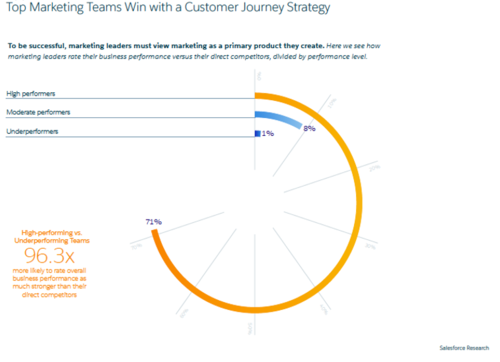New marketing research from Salesforce shows that high performing marketing organizations are 96X more likely to rate the performance of their business stronger than their direct competition.
The report analyzed responses from 4,000 marketers from around the globe, from a number of business formats (B2B/B2C) to determine the difference between high performers and underperformers. What they found is not only ground-breaking, it may be a road map to marketing success.
To further analyze the research findings, I connected with Mat Sweezey, author of "Marketing Automation for Dummies", keynote speaker and regarded as one of the top future of marketing thought leaders, about what separates high performing CMOs/marketing leaders from underperfoming organizations.
Sweezey analysis of the performance gap based on the research is highlighted below:
High performers are not just outpacing their competition in click through, email opens, or other arbitrary metrics - they were also asked how do they compare their overall businesses performance to that of the direct competition. Tellingly, 73% of high performers said their performance is much stronger than their direct competition, where only 1% of underperformers and 8% of moderate performers would said the same.
This shows a significant impact of marketing on overall business performance and when we begin to peel back the layers to see the difference in their actions we can see a clearly delineated path to improvement being laid out by the high performing group.
As with many efforts in business, the path begins at the top.
The report showed that the highest performing marketing organizations have full executive buy in. This metric is often expressed subjectively, but the report shows objectively that 83% high performing marketers report having "their executive team's complete commitment to their marketing strategy." In all, high-performers were 2.6X more likely than underperformers to have complete executive buy in. The lesson here is that without full support it is almost impossible to move quickly and manage the amount of change marketers must undergo to keep up with current consumers.
While executive buy is arguably the largest hurdle to overcome, it is directly tied to the next major difference between high performers and everyone else: budget.
Budget is the key to unlock the modern potential of technology, programs, and techniques. Without full executive buy in you may be given a larger budget this year, but without significant value delivery your budget will likely remain static - a one time budget increase won't cut it. The data shows that high performers are 2.8X more likely than underperformers to substantially increase their spending on marketing tools and tech over the next two years.
Not only are high performers going to be spending more, they already have spent more.
High performing marketers in this report are shown to already have on average 12 marketing tools, a number more than double that of under performers. They have more tools at their disposal and plan on getting more for next year. Executive buy in cannot just be for this year's budget, or a new tool - it has to be a constant investment in the idea marketing is changing in scope and that it's role within the business is expanding.
While it is probably surprising that high performers are using more tools, the data also shows us something else that is very interesting about their success.
When we break down the adoption of all tools, techniques, and technologies in each question high performers outclassed their competition anywhere from 2-11X in each category. Meaning they were on average 5X more likely to do anything than under performers.
The interesting part here is they are only 5X more likely to have larger budgets, use more/different tools, and adopt new techniques, yet when you combine all of these factors together high performers outpace their competition by 96X. The sum of the whole is much greater than the sum of the parts, and the reason why is simple.

Figure 1: The massive gap between high-performing versus underperforming marketers
A recent study from IBM found 75% of all consumers expect businesses to understand their individual needs. The data shows that it takes a large investment in technology across a wide range of mediums to be able to create a single customer view.
With this view, the high performers are then 34.7X more likely to be able to create a personalized omni-channel experience. The omni-channel experience also means creating a consistent experience with all touch points not just marketing. This can only be accomplished with cross-functional internal collaboration.
When studying this fact, we found that high performers are 17X more likely to emphasize collaboration with other business units. It is not just one tool that creates success, but rather the combination of tools organized to create a personalized customer experience at all times, which is the real power of a high performers technology stack.
The roadmap is clear.
High performing organizations see marketing in a new light. They understand the need for constant change, and consistent experiences.
They position marketers as the leaders of the customer journey and provide them the tools to create, manage, and value their efforts correctly. Success takes hard work. Marketers need to buy new tools, adopt new techniques, and getting a larger budget are all parts of being a high performer, but all this by itself will not make you a high performer.
In order to find true success, you must realize that marketing is a combination of efforts from multiple stakeholders - it is necessary for your organization to understand the power of marketing from the C-Suite to other teams. Cross-functional collaboration is a must, as is a company wide focus on creating personalized journeys - that is what set's today's best performing businesses apart from the rest.
This post was co-authored by Mat Sweezey (Twitter: @msweezey), Principle of Marketing Insights at Salesforce.

